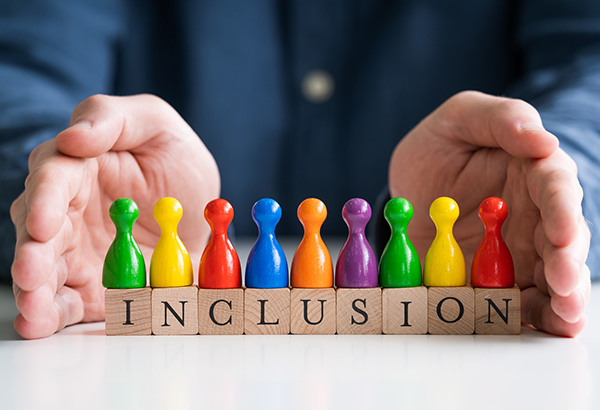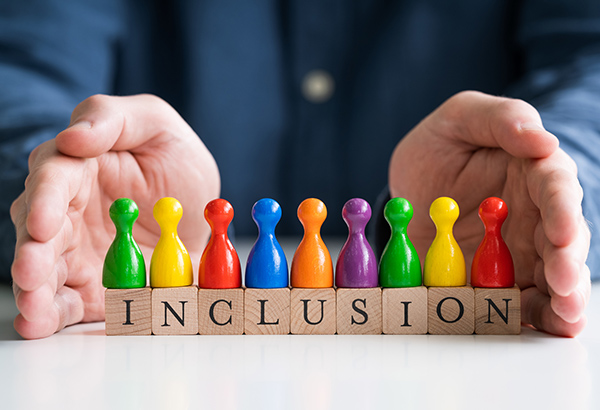What does it mean to infuse equity, inclusion, and diversity into your classroom? Most importantly, what does it mean to your students to provide them with a sense of belonging? These questions aren’t easy, but they are necessary to foster an inclusive classroom and to diversify your content. From culturally responsive teaching, inclusive classroom strategies, teaching diverse learners, gender diversity, and more, we’ll cover an array of topics and strategies you can learn about and start implementing in your own courses to help students feel seen and heard. From articles, free reports, programs, seminars, and courses, this resource guide will present ideas, tools, and techniques that you can start using right away.
Browse the following topics for resources, programs, seminars, free reports, and articles to help guide you in teaching for change through equity, inclusion, and diversity:
Equity in the Classroom
Creating Inclusive Classrooms
Culturally Responsive Teaching
Classroom Dialogue About Race
Gender Diversity in the Classroom

Equity in the Classroom
By now, most educators have seen the images of equity versus equality versus justice, and we argue over the merits of these images. What’s missing is a deeper conversation about what equity means in the classroom, and how our various curricular initiatives contribute to transformation. We tend to talk about equity in ways that strip it of its revolutionary call for social justice. So, as we move forward finding our way to equity, we need a new orientation that recognizes the bonds that connect us. That helps us focus on building our individual and collective capacity by learning together in classrooms and beyond them. May we soon come to realize that the path to equity is always about finding our way. (This blurb is from the article, Finding Our Way to Equity.)
Free articles:
- Finding Our Way to Equity
- Fair and Equal
- Building a Virtual Equity-Driven Learning Community
- From Inclusion to Equity: Pedagogies that Close Achievement Gaps
- Who Am I? A Strategy for Teaching About Power and Privilege
- Free report: You Belong Here: Making Diversity, Equity, and Inclusion a Mission in the Classroom
Teaching Professor articles (requires paid subscription)
- Teaching All Our Students
- Journaling Assignment
- Lost in Interpretation: Making Space for Dialect Differences in the Classroom
Related products
Each 20-Minute Mentor is $19 for individual, on-demand, one-week access, and each Magna Online Seminar is $39 for individual, on-demand, one-week access.

Creating Inclusive Classrooms
What does it mean to be an inclusive teacher? Inclusive teaching involves creating equitable and welcoming educational environments for the diverse learners in our classrooms. This includes (but is definitely not limited to) designing educational experiences informed by the pre-knowledge, skills, demographic backgrounds, and attitudes that learners bring to the classroom; creating an inviting course environment where students feel a sense of belonging; integrating diversity into course content; and being aware of and mitigating any harmful effects of biases (Tanner 2013). Here, you’ll dive into the benefits of an inclusive classroom and how it can help make your instruction more effective.
Free articles
- Five Ways to Promote a More Inclusive Classroom
- An Inclusive Classroom Framework: Resources, Onboarding Approach, and Ongoing Programs
- What two Students Want You to Know About Inclusive Teaching
- How to Structure Your Online Class for Inclusion, Part 1
- How to Structure Your Online Class for Inclusion: Two Principles for Fostering Engagement, Part 2
- Seven Ways You Can Foster a More Inclusive LGBTQIA+ Learning Environment
- How to Build Inclusive Practices in Education
- Using Inclusive Teaching Strategies to Promote Greater Success Among Minority Students
- For Those Who Need it Most: Using Active Inclusivity to Increase Office Hour Attendance and Extracurricular Activities
- Encouraging Your Students Through a Three-Column Activity
- Supporting Learning in Students with Autism: What Do Professors Need to Know?
Teaching Professor articles (requires paid subscription)
- Considering Language When Creating Inclusive Learning Environments
- Tips for Creating a More Inclusive Syllabus
- A Garden, Not a Leaky Pipeline
Related products
Each 20-Minute Mentor is $19 for individual, on-demand, one-week access, and each Magna Online Seminar is $39 for individual, on-demand, one-week access.

Culturally Responsive Teaching
Think back for a moment to when you were a student. Did the scientists you studied in biology look like you? Did the word problems you sweated over in geometry reflect your culture or the neighborhood where you grew up? Did the books you read in history class include the perspectives of your ancestors? For too many people, the answer to all of these questions is “No.”
If students can see themselves and their communities in what they’re learning, then they learn differently—and better. This is the idea behind culturally responsive teaching (CRT). With CRT, students’ cultural knowledge is seen as an asset in the classroom, not something that should be checked at the door. Cultural responsiveness is not new, but in this year of reckoning with racial inequity, there is renewed interest among higher education instructors. The following dives into why cultural awareness is important, how multicultural curriculum strategies can be implemented into your courses, how culture affects learning, and more.
Free articles
- How Open Education Enables Culturally Responsive Teaching
- The Uses of Feminist Pedagogy Before, During, and After the Pandemic
- Meet Them Where They Are: Further Your Own Cultural Humility and Responsive Teaching
- Five Essential Strategies to Embrace Culturally Responsive Teaching
- Dos and Don’ts When Working with International Students in the Classroom
- Culturally Responsive Teaching and UDL
Teaching Professor articles (requires paid subscription)
- Teaching Online with Errol: Effectively Teaching the Multicultural Online Classroom
- Creating Global Moments in Local Classrooms
- Building Global Competence into Postsecondary Curricula
- Creating Global Classrooms
Related products

What are 3 Keys to Teaching Intercultural Competence? 
What Culturally Responsive Teaching Techniques Can I Use to Improve Learning? 
Why is Intercultural Competence Important and How Can it Improve my Teaching? 
Build International Student Success with Intercultural Awareness 
Magna Online Course: Teaching Specific Student Populations

Classroom Dialogue About Race
“When I think about diversity here in college, I can hear myself saying “What if? What if I could go back and talk to my undergrad professors and my graduate professors and sit them down in the times or moments where I felt I was not heard?” I would ask them to start the semester, start the course, or start every class including people’s personal narratives.“
Impacting students with diverse teaching moments and integrating diverse narratives into your content is vital. If you don’t talk about the topics that are hard, if you avoid the much needed classroom conversations, your students will feel and hear it. Teaching is an act of transcendence, reconciling the past with present opportunities for societal transformation anchored in a commitment to challenging injustices while ensuring the humanity and dignity of the oppressed. So, we propose a simple invitation; teach for liberation; teach for change.
Free articles
- Initiating Classroom Dialogue about Race: A Narrative Framework
- Strategies for Antiracist and Decolonized Teaching
- An Anti-Racist Form of Assessment: The C.A.P. Model: Creative. Academic. Practical.
- Proactive Microresistance in a Microaggressive World
- Faculty Hiring: Guidelines for Promoting Diversity
- Retaining Faculty of Color
Teaching Professor articles (requires paid subscription)
- Breaking the Code of Silence about Race in the Classroom
- Using Movies to Facilitate Discussions about Racism and Social Justice: Five Considerations
- Mindset and Stereotype Threat: Small Interventions That Make a Big Difference
- It’s OK to Be Angry, but Work to Bring About Change
Related products

Gender Diversity in the Classroom
Fostering an inclusive classroom environment is especially important. It gives all students the chance to challenge biases and misconceptions, critically think and respond in a sensitive and productive manner, build supportive and mature interpersonal relationships, and succeed academically. For students who identify as LGBTQIA+, we need to remember that they face some unique (as well as some similar) realities as other students. The needs of our gender-variant students are too often overlooked. These resources outline ways faculty can create an atmosphere that supports trans-identified, non-binary, and gender-nonconforming students.
Free articles
- Seven Ways You Can Foster a More Inclusive LGBTQIA+ Learning Environment
- Supporting Transgender Students in the Classroom
- Contemporary Classroom Advice from a Transgender Student
- Graphic Novels, Innovative Teaching, and Student Engagement in the Classroom
Related products

Simple Strategies to Create an Inclusive Classroom for Gender Variant Students 
Advanced Online Seminar: Transgender Students and Creating a Safe, Inclusive, and Legally Compliant Environment 
Transgender Students and Employees: How to Comply with the Latest Title IX Guidance 
Identifying and Eliminating Common Administrative Barriers for Transgender Students















